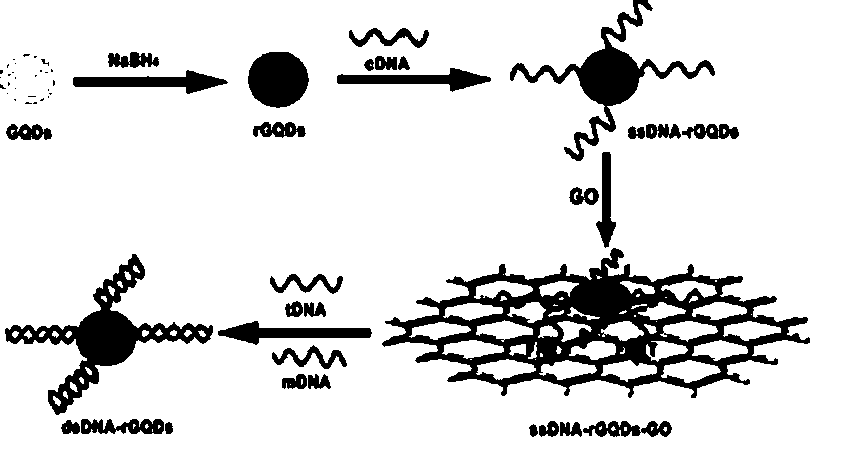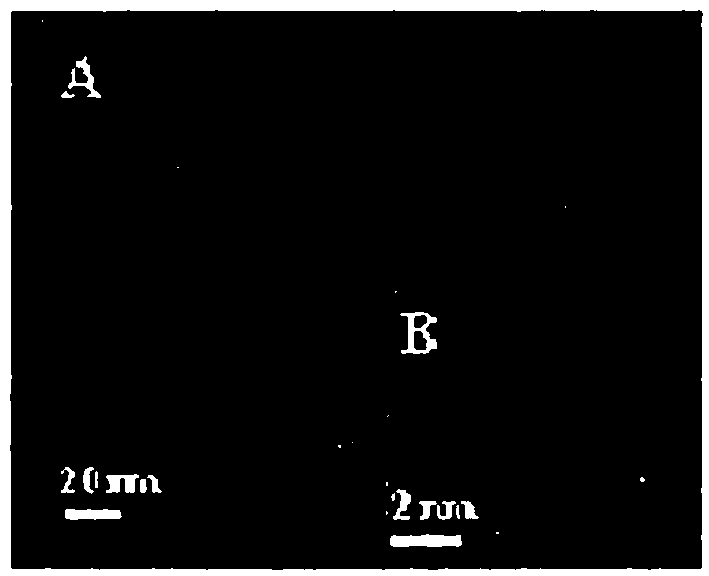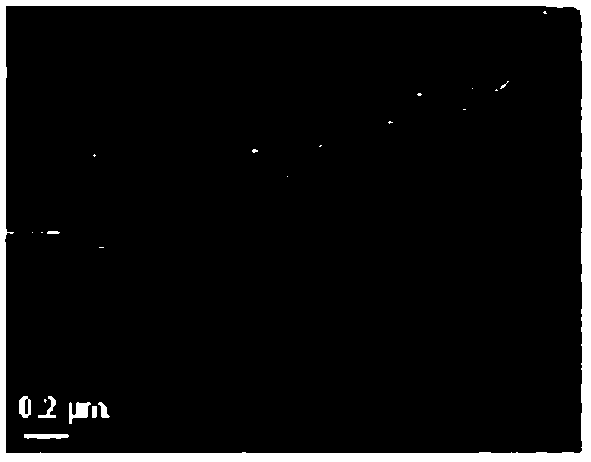Preparation method of fluorescence probe and applications of the fluorescence probe
A fluorescent probe and probe technology, applied in biochemical equipment and methods, DNA preparation, fluorescence/phosphorescence, etc., can solve the problems of fast photobleaching, easy decomposition, short fluorescence lifetime, etc., and achieve strong fluorescent signal and selectivity Strong, water-soluble effect
- Summary
- Abstract
- Description
- Claims
- Application Information
AI Technical Summary
Problems solved by technology
Method used
Image
Examples
Embodiment 1
[0032] Embodiment 1: A preparation method of a fluorescent probe, the probe is obtained by connecting single-stranded DNA with reduced carbon quantum dots capable of emitting blue fluorescence, and the reduced carbon quantum dots are made of carbon quantum dots as raw materials, boron Sodium hydride is used as a reducing agent, and a chemical reduction method is used to modify the surface of the carbon quantum dots to obtain reduced carbon quantum dots capable of emitting blue fluorescence. The specific steps are:
[0033] A. Synthesis of carbon quantum dots
[0034] Add 0.3g of graphite powder into a mixed solution of 180mL of concentrated sulfuric acid and 60mL of concentrated nitric acid, ultrasonicate for 2 hours, heat, stir and reflux at 80°C for 24 hours, after the reaction is completed, cool to room temperature and dilute to 800mL with distilled water, and adjust the obtained brown-black solution with sodium carbonate The pH value is neutral, and a brown solution is ob...
Embodiment 2
[0042] Embodiment 2: A preparation method of a fluorescent probe, the probe is obtained by connecting single-stranded DNA with reduced carbon quantum dots capable of emitting blue fluorescence, and the reduced carbon quantum dots are made of carbon quantum dots as raw materials, boron Sodium hydride is used as a reducing agent, and a chemical reduction method is used to modify the surface of the carbon quantum dots to obtain reduced carbon quantum dots capable of emitting blue fluorescence. The specific steps are:
[0043] A. Synthesis of carbon quantum dots
[0044] Add 0.1g of graphite powder to 120mL of concentrated sulfuric acid and 40mL of concentrated nitric acid mixed solution, ultrasonic for 1 hour, heat and stir at 60°C and reflux for 22 hours, after the reaction is completed, cool to room temperature and dilute to 600mL with distilled water, and adjust the obtained brown-black solution with sodium carbonate The pH value is neutral, and a brown solution is obtained. ...
Embodiment 3
[0052] Embodiment 3: A preparation method of a fluorescent probe, the probe is obtained by connecting single-stranded DNA with reduced carbon quantum dots capable of emitting blue fluorescence, and the reduced carbon quantum dots are made of carbon quantum dots as raw materials, boron Sodium hydride is used as a reducing agent, and a chemical reduction method is used to modify the surface of the carbon quantum dots to obtain reduced carbon quantum dots capable of emitting blue fluorescence. The specific steps are:
[0053] A. Synthesis of carbon quantum dots
[0054] Add 0.55g of graphite powder to 240mL of concentrated sulfuric acid and 80mL of concentrated nitric acid mixed solution, ultrasonic for 3 hours, heat, stir and reflux at 100°C for 26 hours, after the reaction is completed, cool to room temperature and dilute to 1000mL with distilled water, and adjust the obtained brown-black solution with sodium carbonate The pH value is neutral, and a brown solution is obtained....
PUM
 Login to View More
Login to View More Abstract
Description
Claims
Application Information
 Login to View More
Login to View More - R&D
- Intellectual Property
- Life Sciences
- Materials
- Tech Scout
- Unparalleled Data Quality
- Higher Quality Content
- 60% Fewer Hallucinations
Browse by: Latest US Patents, China's latest patents, Technical Efficacy Thesaurus, Application Domain, Technology Topic, Popular Technical Reports.
© 2025 PatSnap. All rights reserved.Legal|Privacy policy|Modern Slavery Act Transparency Statement|Sitemap|About US| Contact US: help@patsnap.com



